La Selva

La Selva Biological Field Station, near Puerto Viejo. The station comprises 3,900 acres of tropical wet forests and disturbed lands. Some 73% of its area is primary forest. La Selva is one of the world’s premier sites at which to conduct ecosystem research -- 240 scientific papers are published annually from research conducted there.We will take hikes into the forest by day and night and participate in activities that will help everyone to understand the complex interactions of flora and fauna in a tropical rainforest. Our intent is to carry out some original scientific research over the course of several days. Melody took this picture along one of the many mossy cement trails near the research complex. See the following link for more information about La Selva: http://www.ots.duke.edu/en/laselva/
Wednesday May 21
Hotel view

At our hotel, the main street (Avenida Central) had been noisy far into the night and started up again early this morning. This is a view from our balcony. We left for the two-hour trip to La Selva right on time and stopped several places along the way to enjoy the view standing still.
Troopers.

Our trip lasted two hours, most of which was on the PanAmerican coming though the mountains north of San Jose. Amazing mountains covered in clouds and mist, and deep ravines lined with Gunnera and other native species.
Faithful bus
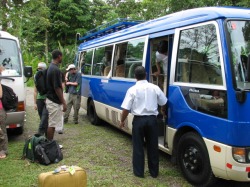
Our driver's name was Roy Simson and he made sure to point out interesting features along the way.
Jurassic Park?
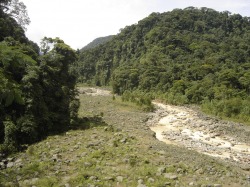
The view from this bridge is reportedly in one of the Jurrasic Park movies.
Ready to explore La Selva
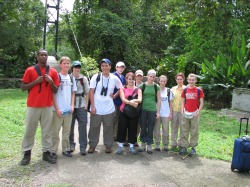
Jeron, Tyler, Asher, Evan, Graham, Anna, Marcus, Sarah, Maxine, Melody, and Morgan. Frances is taking the photo.
Suspension bridge.
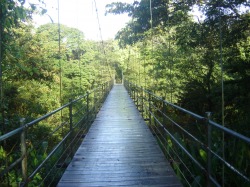
It bounces and sways at least 100 feet long over the Puerto Viejo river between the laboratory area and the administration buildings. We crossed this bridge many times during the day.
Old growth.
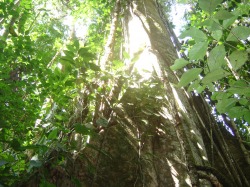
Golden Orb spider
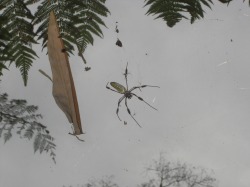
Web is like woven threads of gold in the sunlight. Beautiful large spider, width of a person's palm.
Leedle frogy
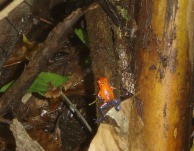
Dendrobates pumilio, Strawberry Poison-dart Frog. This one is immature, but they won't get any bigger than a quarter.
Thursday May 22
Early morning birding, 5:15-7:30am.
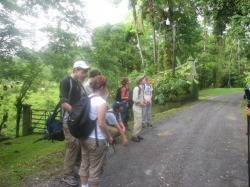
Species list: (to come)
Science projects with leaf-cutter ants: 2-day project with powerpoint presentation to the whole group.

This group evaluated the average weight and surface area of the leaf sections carried by ants in 4 different colonies. Asher, Jeron, Sarah, Maxine and Graham were members of this group.
Leaf-cutters use the pieces of leaf to feed a specific fungus in the depths of the colony. This mutualism is obligate -- the ants die without the fungus, and the fungus dies without the ants. Although the lipids obtained from the fungus only constitute 5 percent of their diet, they are completely essential. When a queen flies off to create a new colony, she carries a little bit of the fungus with her.
Weight room.
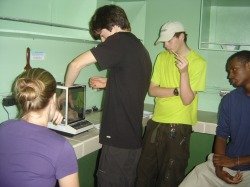
Taking the dry weight of the leaf pieces for each of the four colonies. The were stored in paper bags overnight in the drying oven to eliminate water and humidity as weight factors. The weighing process had to be fast and coordinated because humidity begins to take effect in a matter of seconds.
Ant trail.
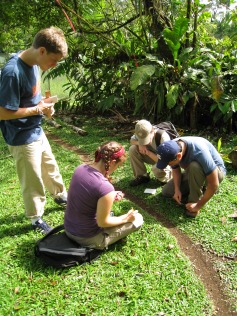
This group looked at the responses of leaf-cutter ants to obstacles in their established trails (usually 4-5 inch wide cleared "highways" leading to the underground colony from several directions). Members included Tyler, Anna, Evan, Marcus, and Morgan (who took this photo).
Ant obstacle.
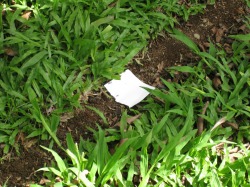
After some time and failed attempts, ants sense a phermone trail of the successful crossers and continue using the same route.
Friday May 23
Sloth - rare sighting.
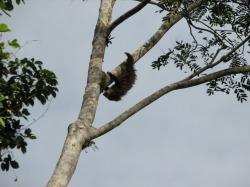
Students were writing the powerpoints for their project presentation when an older student from one of the other groups pointed this out to us in a tree near the classroom and laboratory buildings. Two-toed sloth, coming down the tree late morning to make its way to another trunk by a vine connecting them close to the ground.
Forest view.

Thick, dense, dark green vegetation with many plants hanging from or perched upon others.
Beautiful river.
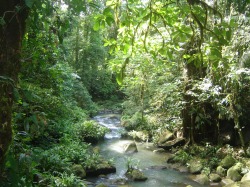
We went for a 3 hour walk/hike this afternoon. Highlights were a hook-nosed viper, the calls of howler monkeys, and this lush river.
